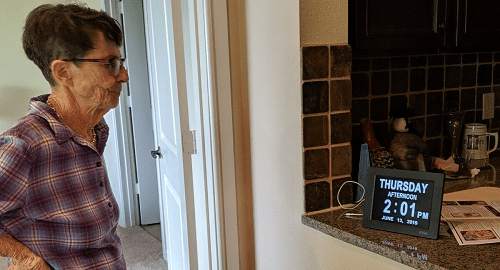7.1.21 – CEPro

Julie Jacobson • July 1, 2021
I had one job to do: Find a super-simple thermostat for a loved one with dementia. No bells, no whistles, nothing to touch or see beyond the basics. Just an unmistakably clear display of the current temperature; up/down buttons or rotary dial to adjust the temperature; heat/cool auto-changeover; backlighting; battery powered, with no C-wire required.
Bonus points for always-on display (no motion triggers) and remote access for friends and family. Penalties for programmable, eco, geo and other smart options. Additional demerits for extraneous information, mechanical elements and flourishes.
Price was no object. We’d pay more for less.
How difficult could this job be, especially for someone so entrenched in the smart-home industry? As it turns out, it’s hard. I failed. Even with the kind help of so many experts in my network, I failed. Granted, I gave up pretty easily but why should anyone have to work at all to find a decent solution in this case?
The dementia thermostat should be available in the online dementia store, next to clocks, phones, radios, TV controls, pill dispensers, calendars, wrist watches, microwave ovens and myriad other dementia-friendly goods.
Unfortunately, there is no dementia store that I can find – not surprisingly, since there would be nothing to sell.
Perhaps a dementia-friendly thermostat is a big ask. What about a dementia-friendly clock? When I searched for one earlier this year, I found exactly that: one (with several variations of the same theme).
We weren’t as lucky in our quest for a dementia-friendly watch. We found none. We looked everywhere for a watch that clearly showed the time, day and date. We didn’t care if it was big, ugly or expensive. It just needed to be clear enough to read, durable enough to wear full-time, and easy to slip on and off. Nothing came close.
Our efforts are completely misguided. Give us simple controls and a network of pros to sell and install them. That’s the low-hanging fruit.
Not surprisingly, we found no microwave oven, telephone system, TV controller or music player that our loved one could operate.
I write this not to lament the sad state of elder-friendly technology, but to draw attention to this inexplicable void. I mean, I’m shocked. The “aging in place” movement trudged along slowly for a couple of decades, but positively exploded over the past few years with a rush of interest, activity and highly publicized accomplishments.
Perhaps we’ve come a long way in helping seniors live at home longer with advancements in fall detection, activity monitoring, telemedicine, sleep aids and the like. But what about quality of life?
There’s a long, agonizing stage in dementia when the sufferer still has much of her wits but can’t do everyday things. She might hold intelligent conversations about worldly events, crack jokes like a pro, reminisce about people and happenings from decades ago, and recall with uncanny precision how (shamefully) long it’s been since the last her daughter called. But she struggles to hang up pants, put on tops, turn on lights, follow a calendar, eat a meal, change the temperature, answer the phone, or make a call. She already gave up watching TV because she will never succeed.
Through all of this, she is painfully aware of how useless she’s become and disparages her loved ones for ignoring her plight. “I can’t do anything myself. I hate my life. You promised to fix my phone and my thermostat and my TV.”
The attacks hit me especially hard because my industry should have the answers. Instead, our collective energy goes into keeping the elderly alive and at home for as long as possible. Our efforts are completely misguided. Give us simple controls and a network of pros to sell and install them. That’s the low-hanging fruit.
